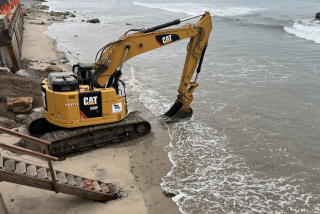Homesâ landscaping edges onto public sand in Newport Beach
On the tip of Balboa Peninsula, where multimillion-dollar homes sit snug against the sand and the legendary waves draw crowds of bodysurfers, an unlikely battle is taking shape.
At the center are the lawns, lounge chairs, hedges and playground equipment â even a rusty metal shark sculpture â that for years have sprawled out from oceanfront homes onto the public sand.
Itâs all illegal, says the state of California, which has ordered homeowners along some of Orange Countyâs most coveted coastline to rip out the landscaping, sprinklers and all the other upgrades that have crept steadily seaward.
PHOTOS: Encroaching onto public sand
The order from the state Coastal Commission reignites the perennial clash between the government and homeowners up and down the coast who have sought to claim the sand next to their homes and, in so doing, given visitors the impression that the public beach is their private backyard.
Some of the incursions are extensive. There are full lawns, stone walkways, flower beds, fire pits, birdbaths and colorful displays of cactuses and succulents extending far beyond the public property line. Fences and irrigation systems have been installed, landscapers brought in, gardeners hired. At night, some yards are illuminated with outdoor lights.
When Newport Beach put up âpublic welcomeâ signs several years ago to remind people whom the beach really belonged to, most disappeared in the middle of the night.
âI insisted on those signs being up because I think itâs intimidating to the public to see a lawn and a lawn chair and not realize that thatâs still the publicâs land,â City Manager Dave Kiff said. âAnd the public has a right to throw a picnic blanket on it and have a picnic.â
Some neighbors said they are mobilizing as a community and hiring a lawyer to fight the crackdown.
One woman, a longtime resident who â like others here â declined to give her name for fear of retribution from the Coastal Commission, said the plot of grass she maintains on the public beach protects her home from blowing sand and shields her from beachgoers.
âWe know itâs not our property, but thereâs really no reason whatsoever to make us take the grass away. Itâs nothing,â she said. âThereâs so much beach already that anyone can walk on.â
Others called it a trivial matter for state involvement, but coastal officials donât think so.
Though each shrub and flower pot on its own may seem inconsequential, together they block off a substantial amount of public beach, said Charles Lester, executive director of the Coastal Commission.
âSo it requires vigilance, monitoring and action to protect the publicâs space,â he said. âThereâs always an inherent tension between private and public space on the shoreline.â
It has been a recurring problem, particularly in those parts of Southern California where homes sit right next to the sand, with no barriers to curb the temptation to push out onto the sand.
In neighborhoods like Venice and the peninsula in Long Beach, the agencyâs past warnings â which can threaten fines of up to $15,000 a day â have persuaded property owners to yank out their offending plantings.
On other occasions, residents have dug in their heels. In 1999, some homeowners on San Diegoâs Mission Beach faced misdemeanor criminal charges for refusing to remove walls, fences and other obstacles.
Coastal Commission officials said they began their Newport Beach investigation last year after receiving complaints. They started sending letters to property owners in February, focusing only on the lawns and gardens that displace large swaths of public beach.
âThese seem to be cropping up more and more out there and we seem to be losing more beach,â said Andrew Willis, an enforcement analyst for the agency. âIt seems that these are proliferating, becoming more extensive and taking on more of the characteristics of private property than a public beach.â
This is not the first time the state has tried to crack down in Newport Beach.
After the Coastal Commission issued similar warnings in 2006, the city reached an accord with homeowners to allow ground cover like ice plant but prohibit irrigation systems and lawns. The policy hasnât worked, coastal officials said, and the incursions have only gotten worse.
Richard Spurzem, a private investor who has lived in a modern wood-and-glass home near the tip of Balboa Peninsula for three decades, has kept a file of letters and reports on the issue since 2006. Thatâs when an inspector took photographs of the ice plant and rocks behind his home, following up with a letter ordering him to remove âunpermitted rocks and a hose bibâ from the public sand.
âThis has got to be a joke,â he thought at the time.
The spigot and rocks are still there, and Spurzem is surprised that the issue is resurfacing.
âI think the Coastal Commission has got a lot better things to do than that,â he said. âItâs nitpicking and itâs a waste of time.â
Spurzem will probably be spared the governmentâs scrutiny this time around.
But his next-door neighbor, who a few years ago installed a verdant lawn that extends about 30 feet onto the public beach, may not. The plot, furnished with a swing set and a small picnic table, is guarded by a neatly trimmed hedge and a knee-high fence.
Though it may irk beach officials, it doesnât bother Spurzem.
âAs a matter of fact,â he said, âI think it looks pretty good.â
PHOTOS: Encroaching onto public sand
More to Read
Sign up for Essential California
The most important California stories and recommendations in your inbox every morning.
You may occasionally receive promotional content from the Los Angeles Times.











